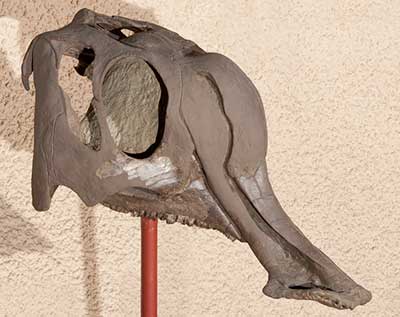Corythosaurus
(koh-RITH-oh-SAW-rus)
| Quick Facts | |
|---|---|
| Name Meaning: | Helmet Lizard |
| Distribution: | Northwestern America |
| Time Period: | Late Cretaceous, 75 Ma |
| Length: | 30 ft (8.4 m) |
| Weight: | 4 tons |
| Diet: | Herbivore |
| Linnaean Classification | |
| Kingdom: | Animalia |
| Phylum: | Chordata |
| Class: | Reptilia |
| Superorder: | Dinosauria |
| Order: | Ornithischia |
| Family: | Hadrosauridae |
| Subfamily: | Lambeosaurinae |
| Genus: | Corythosaurus |
| Cladistic Classification | |
| |

History
The Corythosaurus is one of the best-known North American dinosaurs due to the discovery of more than 20 specimens. It was first discovered by Barnum Brown in 1912 at the Red Deer River in Alberta, Canada. This find was excellent because of the fossilized skin samples discovered. In 1916 a ship was sent from Canada to Britain with two of these specimens but was sunk by a German surface raider and lost in the Atlantic. At first, the Corythosaurus was divided into seven species due to variations in the crest size. However, in 1975 Peter Dodson studied the species and concluded that they were all part of the same species, and that the variations were due to gender and growth stages. |
| Corythosaurus casuarius skeleton partially covered in skin. |
Description
The Corythosaurus was a large herbivore with a duck billed snout and an s-shaped neck. The mouth contained hundreds of small interlocking teeth that continually replaced each other as they grew. The distinctive feature is the animal's large hollow crest above its head from which it gets its name. The fossilized skin was pebbly and not overlapping as it is with many other reptiles. At first it was thought to be a good swimmer because of the seemingly webbed hands and feet. However, this was later found to be deflated padding much like modern mammals.Lifestyle
Discoveries of the Corythosaurus have led most Paleontologists to believe that the dinosaur traveled in herds. It may have also traveled in the company of other herbivores, from the discoveries of many Corythosaurus in the company of other dinosaurs. The large crest was hollow and connected to the nasal cavity. Any vocal sounds made by the Corythosaurus would have passed through the hollow crest thereby amplifying the sounds. It was probably used to make loud trumpet sounds while using the crest as a display for competition and mating.
ScienceViews Writer: Jason Hamilton.
Copyright © 2005-2010 Calvin & Rosanna Hamilton. All rights reserved.